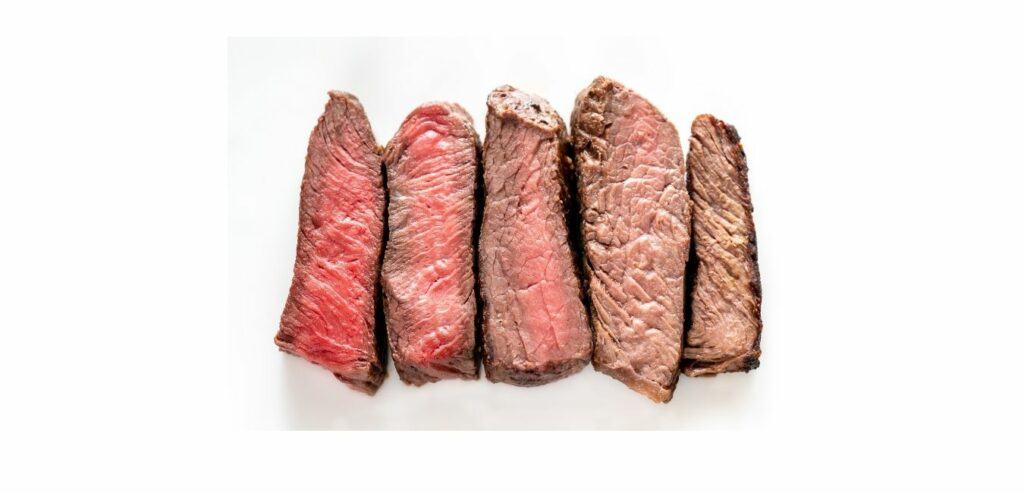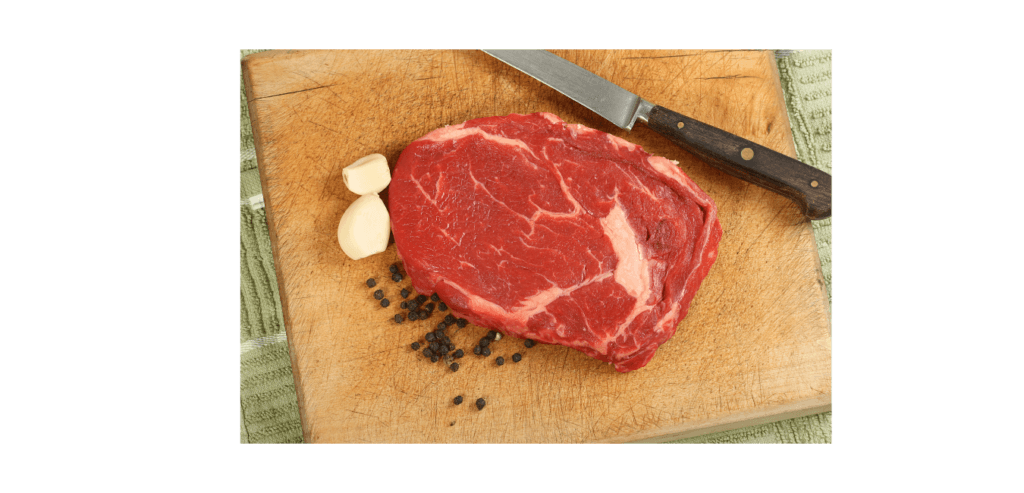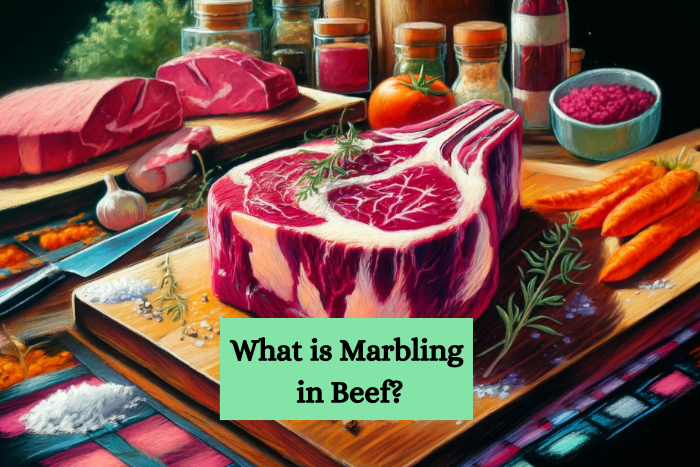Marbling in beef refers to the white flecks of intramuscular fat, enhancing flavor and tenderness. Higher marbling equates to better taste and texture, crucial for quality assessment in cuts like ribeye and sirloin.
When shopping for meat, do you go for the package with the least amount of marbling? You know, that package with that beautiful red meat with no fat in it?
I did many years ago and I couldn’t for the life of me figure out why my steak just didn’t melt in my mouth as it did at the restaurant. I thought I wasn’t cooking it right.
Well ok, that was one of the reasons but it wasn’t the only explanation.
What Is Marbling in Beef?
As stated above it is the white streaks or flecks throughout the meat called intramuscular fat. When cooked the fat melts into the meat resulting in added flavor, tenderness, and juiciness in every bite.
A word here about cooking. You can have the best piece of marbled beef, but if it is not cooked correctly you will end up with a tough, chewy piece of meat.
But cooked the right way a less tender cut of meat will melt in your mouth. Check this article regarding cooking methods.
I’m adding the following facts for fun. There is no way I can afford the first two types of beef.
They are for the rich and famous and I do not fall into either category. But I just had to add them and maybe dream just a little and drool some too!
Types of Cattle with High Marbling
Wagyu beef is famous for its excellent marbling and for its high price as well. What is Wagyu?
It translates to “Japanese cow”. It is a cattle breed that originated in Japan and is considered by many as the best beef in the world.
It is found in four different types of Japanese cattle. Then there is American Wagyu beef, which comes in second on the marbling scale.
A crossbreed with Japanese cattle in the mix. Still a very high-priced piece of meat.
For those who cannot afford the high-priced Wagyu beef, don’t despair. There is a third choice to be had.
Black Angus beef! The Black Angus originated in Scotland.
This alternative is a little bit more affordable and easier to come by. While all cattle have some marbling, the three breeds above have the highest marbling.
The more marbling, the tastier and more expensive the meat is. Then we come to the grading of the beef.
The Different Grades of Beef
All cattle are graded either Prime, Choice, or Select. The cattle are primarily graded on age and the amount of fat mixed with muscle between the 12th and 13th rib.
Other considerations are the breed of cattle, the amount of exercise, and how they were fed. In my research, I learned that cattle raised on grain will have more marbling.
Prime
The highest quality of beef available, with the most marbling. The best cooking method is dry.
Choice
Less marbling than prime. The best cooking method is dry.
A little note here. Choice-grade certified Angus Beef is generally better quality than an average cut of choice beef.
Select
Uniform, leaner quality. Still tender but less marbling.
The best cooking method is either marinated or braised.
Ribeye Steak Vs Filet Mignon
The ribeye steak is the juiciest, most marbled cut of beef, and is from the center of the rib section. The filet mignon on the other hand is the most tender cut of beef because it comes from the tenderloin, an area that is lean and contains less connective tissue.
The ribeye delivers juiciness and flavor whereas the filet mignon is tender. Did you ever wonder why there is a piece of bacon wrapped around the outside of a filet mignon?
The filet mignon does not have much fat. The bacon helps to hold in the juices and also adds some flavor.
So if you didn’t know, now you do. If you did know, well kudos to you.
How Do You Like Your Steak?

Rare – Cool red center. Internal temperature 125 degrees.
Medium Rare – Warm red center. Internal temperature 135 degrees.
Medium – Warm pink center. Internal temperature 145 degrees.
Medium Well – Slightly pink center. Internal temperature 150 degrees.
Well Done – Little or no pink. Internal temperature 160 degrees.
I am that customer who cooks and chefs hate. I prefer my steak between medium rare and medium.
The more you cook a steak the tougher it is going to be. I’ve tried to explain this but some just shudder at any red or pink in the meat.
They cannot get past this. My daughter happened to be one.
She didn’t like steak because it was tough. Then she ate one cooked the way her husband likes steak.
Medium rare to medium. And guess what?
Yep, she likes steak now. On the other hand, my sister just doesn’t care for steak no matter how it is cooked.
Give her a porkburger and she is one happy camper. My husband prefers a bacon cheeseburger.
I can’t believe I belong in this family. I love steak, especially when it is cooked right.
Where it is so tender it practically melts in your mouth with every bite. And the flavor, oh my!
Have you ever heard of magic fingers? Well, that’s what I call them anyway.
My dad possessed what I call magic fingers. They could just touch a piece of beef and tell at what degree of doneness the meat was.
If it’s in the genes it skipped me. I just don’t know how they do it.
I have to rely on a meat thermometer.
Why is Your Meat Tough and Chewy?
It all comes down to marbling and most importantly, the cooking method. If the meat is undercooked the fat has not converted into flavors and the juices have not started to flow.
Overcooked, the heat erodes all the fats and juices leaving the meat hard which equals tough and chewy.
My Final Thoughts
- Definition of Marbling: Marbling refers to the white flecks and streaks of fat within the lean sections of beef, similar to the pattern seen in a well-marbled ribeye steak, which enhances both flavor and tenderness.
- Impact on Flavor: The fat within the marbling melts during cooking, infusing the meat with rich, beefy flavors, akin to how butter enhances the taste of a croissant.
- Tenderness Enhancement: Marbling contributes to the tenderness of beef because the fat renders and lubricates the muscle fibers during cooking, making the meat more succulent, much like how a well-marbled Wagyu steak is notably tender and melts in the mouth.
- Grade and Quality Indicator: Higher levels of marbling are often associated with premium grades of beef, such as USDA Prime, indicating superior quality and desirability, similar to how aged cheeses are prized for their depth of flavor.
- Cooking Considerations: Meats with more marbling are typically best cooked using methods that allow the fat to render slowly, enhancing flavor and tenderness, which is why slow-roasting or grilling are popular methods for cooking fatty cuts like marbled brisket or ribeye steaks.
Marbling is those white streaks or flecks you see in the meat. The more marbling, the more flavorful and tender it will be because the fat melts into the meat giving you a delightful eating experience.
You must also keep in mind the cooking method and level of doneness. A chuck steak has little marbling but is full of beefy flavor and can be one of the most tender steaks.
If It is cooked correctly! Long and slow by braising in the oven.
If you prefer your meat grilled or pan-fried then the more marbling the tastier and tender it will be. Have you ever had Wagyu beef?
I would love to hear about your experience. Chalk it up to curiosity on my part.
Which one would you choose?


Please leave me a comment below. As always, have a wonderful day!
FAQ
Q1: What is marbling in beef?
- Marbling in beef refers to the white flecks and streaks of intramuscular fat found within the lean sections of meat. This fat is key to enhancing the beef’s flavor, tenderness, and juiciness when cooked.
- The presence of marbling is a significant quality indicator in beef, heavily influencing the meat’s taste and texture. Higher levels of marbling generally indicate a premium grade of beef, such as USDA Prime, which is known for its superior taste and texture.
Q2: Why is marbling important in beef?
- Marbling is crucial because it contributes to the meat’s flavor and tenderness. As the beef cooks, the marbling fat melts and renders, infusing the meat with richness and making it more succulent and flavorful.
- Additionally, marbling acts as a natural tenderizer during the cooking process. It helps the meat retain moisture and stay tender, which enhances the overall eating experience, especially in cuts like ribeye and sirloin.
Q3: What impact does marbling have on cooking beef?
- Meats with higher marbling are often best cooked using methods that allow the fat to render out slowly, such as grilling or roasting. These cooking methods maximize the flavor and tenderness provided by the marbling.
- Cooking beef with adequate marbling using appropriate methods ensures that the meat does not become tough or chewy. Properly cooked marbled beef will be tender and flavorful, rather than dry and difficult to chew.
Q4: How does beef grading relate to marbling?
- Beef grading, such as USDA classifications of Prime, Choice, and Select, is heavily influenced by the level of marbling. Prime grade beef, which has the most marbling, is considered the highest quality and is typically served in high-end restaurants.
- Choice and Select grades have less marbling than Prime. Choice grade beef is still of high quality and offers good flavor and tenderness, suitable for most cooking needs, while Select grade beef is leaner and may require careful cooking to maintain tenderness.

I’m Diane, a culinary enthusiast who loves to share my cooking adventures and knowledge with you.
This blog is my cozy corner on the internet where I unravel the secrets behind making everyday cooking simple, enjoyable, and downright delicious.
Whether it’s unlocking the flavor potential in chicken or figuring out why your mashed potato cakes won’t hold together, I’m here to guide you through.
Join me as we explore various dishes, solve common kitchen dilemmas, and discover new recipes that will make you fall in love with cooking all over again.
Cooking is an adventure that’s best shared, so let’s get started!

